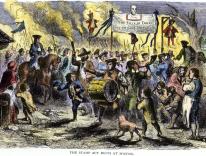
Bernardine Evaristo first appeared on many literary radars when her novel Girl, Woman, Other was awarded the Booker Prize in 2019. “I became an overnight success,” says Evaristo, “after forty years working professionally in the arts.” She also became the first Black woman to receive the Booker, and her novel is charged with enough energy to qualify as a literary force of nature. Empathetic, funny, smart, and innovative, Girl, Woman, Other is written in the voices of twelve characters—eleven women and one non-binary person––whose artistic and love lives intersect at crucial points. The novel is also written in free verse, a form that doesn’t often attract the broad audience Evaristo has finally found.
As her new fans have now discovered, Bernardine Evaristo has been writing surprising, experimental novels for decades. One of the surprises is how accessible and appealing her genre-busting, fluid prose (and/or poetry) can be. As she puts it in Manifesto, her memoir and account of her writing life, she doesn’t want her readers to need “a doctorate in experimental fiction” to read her stories, so she employs straightforward language as she breaks new structural ground. Her subjects can be surprising, too: though she is mostly focused on the lives of women, her polyvocal narratives take on the full spectrum of gender identity. Mr. Loverman (2013) utilizes the voice of a married gay Londoner from the Caribbean whose delight in himself is both witty and affecting (and complicated in satisfying ways when the second half of his story is told in his wife’s voice). Blonde Roots (2008), an alternative history that turns slavery inside out, channels the voice of a white European woman captured, transported, and enslaved by Africans. Evaristo’s interest in history has sent her even deeper into the past: intrigued by the historical accounts of an early Black presence in Britain, Evaristo leapt back two millennia to arrive at the year 211 as the time frame for The Emperor’s Babe (2001), the story of a Nubian teenager in Roman London. Despite the ancient setting, the novel’s language is strictly twenty-first-century, full of raw and clever power that manages to suggest “the melting-pot origins of the English language.”
As one of the readers who came late but delighted to this wide-ranging oeuvre, I was pleased to hear that Evaristo had published this Manifesto, especially since I have frequently assigned fiction-writing students the task of composing their own manifestos arguing for the kind of fiction we should be writing in the twenty-first century. Evaristo’s version turns out to be a hybrid personal memoir and a meditation on writing; the book does append a perfunctory two-page manifesto, but what looks like an afterthought intended to deliver on the title’s promise is not an exemplary model (indeed, it’s one of the book’s few examples of perfunctory writing). I wouldn’t call Manifesto the best place to begin exploring Evaristo’s writing, nor for that matter would I call it entirely successful. Nonetheless, it’s well worth a read for its intriguing personal history, its irrepressible spirit, its conceptual clarity, and its clear-eyed description of the challenges of a writing life, particularly in an English publishing world that was, for years, even more neglectful of Black writers than American publishers. Manifesto is also an excellent companion to Evaristo’s semi-autobiographical novel, Lara.
Evaristo opens Manifesto with a description of what her parents endured as an interracial couple in 1950s London. Her mother, of mostly Irish, English, and German descent, was training to be a teacher when they met; her father, newly arrived in London from his native Nigeria, was learning welding. Interracial marriages were uncommon, and Evaristo’s maternal grandmother was dismayed; other relatives shunned the family for years. Evaristo, the fourth of eight children born in a ten-year span, says she was a “bona fide subaltern” in south London.
But her parents were determined to make the marriage work, and for thirty-three years, they managed to do so. The challenges were constant: an old dilapidated house; racist taunts; feeding, clothing, and educating ten family members on one income. Evaristo’s mother Ellen, who did not return to the classroom until her youngest was in school, was good with money and with her children: she “had a kind of earth-mother vibe going on,” as Evaristo puts it.
Evaristo’s portrait of her “militaristic” father—delivering long lectures or whacks with spoon and belt—is more vivid. Having no use for two old pianos, he chopped them into pieces and burned them in the garden, where he also had his children cut the grass with machetes. Evaristo claims she “didn’t have a proper conversation” with her father as a child and despised him as a teenager. But as she came into her adulthood, she began to appreciate the strength and ingenuity that allowed him to survive in London: he “kept a hammer at the side of his bed,” challenged all insults, and, though taciturn at home and a non-Catholic, was a gregarious member of the local Catholic Club. He taught himself plumbing and founded his own business; he also became an enthusiastic trade unionist, and eventually a Labour Party Councillor. Evaristo’s account of learning to love her father is honest, complicated, and moving without being in the least sentimental.
Both parents were devoted to social and racial justice, and both were politically active. Unlike her father, Evaristo’s mother Ellen was a faithful Catholic. The couple raised all eight children in the Church and bargained for tuition breaks at Catholic schools. Evaristo’s memories of “theoretically religious” clergy are bitter: she recalls priests in the confessional “reeking of alcohol” and says they “never once extended a hand to offer any interest or assistance to the only black family in their flock.” Indeed, what the family believes will be the first pastoral visit by a priest turns out to be a request that the Evaristos sell their house to the parish. One priest, unaware that Ellen is married to a Black man, talks about the “darkies.” A “cruel” priest interrupts Mass when the large family traipses in late. By the time she is fifteen, Evaristo has left the Church, as all eight siblings and her mother will eventually do.
Yet Evaristo credits her childhood vision of Mary for her belief in the “unassailable goodness of women” and the “dramatic and poetic spectacle of the church services” for her trajectory as writer. She does not explore whether her own lifelong pursuit of racial and gender justice or her seemingly boundless narrative empathy might have been influenced by her early Catholicism—the wounds run too deep. Her rejection is complete.
That rejection was fueled in part by the Church’s condemnation of her own sexual experimentation. In her twenties, Evaristo lived as a lesbian, until a harrowing affair with an older woman led her to rekindle her attraction to men. Though she devotes considerable narrative space to her love life, her accounts aren’t in the least titillating or shallow: she ties each affair to her growth as an artist and especially to her increasing self-confidence. Now long married to a supportive man, she quotes a friend’s observation that “marriage was freedom” with approval. “I can’t imagine one night stands now,” she says, “to expose your naked body to a complete stranger in the pursuit of fleeting pleasure?” She still identifies as non-binary and remains intrigued by sexual pleasure as a means of communion with other humans. She holds herself to strict account when she recalls her own youthful callousness to needy lovers.
Indeed, she holds her entire life to strict account; other than J. M. Coetzee’s memoirs, I can’t recall another that holds its subject to such scrutiny. While Coetzee is pitiless in his self-judgment, however, Evaristo is bemused and as forgiving of herself as she is of others. She began her artistic life as an acting student, in a community theater arts program that would have a tremendous impact on her role as a Black writer determined to mentor and nurture beginning Black writers and to support people underserved by art. In drama school she was delighted to finally be in a classroom with other Black women, and with two of the friends she made there founded the Theatre of Black Women, the first of its kind in England. She was only in her twenties and already acting, writing plays, and administering the company, which meant finding grants and other funding. “Running a black women’s theatre company,” she says drily, “required a certain feistiness and bloody-mindedness.”
When she transitioned to poetry and then fashioned that poetry into prose, feistiness served her well. Some of the most fascinating pages in the book narrate her refusal to accept rejection: all her life, she has been persistent in re-applying for grants she has been denied, finding publishers after manuscripts have been rejected, and especially in rewriting manuscripts over and over and over—novels that began in poetry became prose, and vice versa. Her verse novel, Lara, a fictionalized exploration of her own Nigerian, Brazilian, Irish, English, and German heritage, was published first in 1997 and completely rewritten for a second release in 2009. It was in Lara, she says, that she “discovered my sense of humor as a writer.” She speaks of rewriting pages forty times and manuscripts that might take five major revisions; both estimates sound right to me, as does her account of abandoning novels that just weren’t working. What she makes clear to those embarking on a writing life is that novels take years, require single-minded determination, and almost always come without financial reward.
Even pre-Booker, though, the rewards have been apparent in Evaristo’s life. She has survived for long stretches in voluntary and satisfied poverty but in increasingly clearer accordance with her own politics and principles. She’s also grown mellower, as a person and as an artist. In the process of digging deeper and deeper into her family background for Lara, Evaristo found empathy and understanding for the grandmother who once objected to her parents’ marriage and discovered a good deal more about her father’s Brazilian roots. Her desire to understand a whole range of unique, idiosyncratic characters of every race and gender has sent her deep into the library and around the globe for research dives.
Many of Evaristo’s observations about the writing life will be useful to readers and writers alike. The big surprise here is that the form of this book is, for once, not in the least innovative: an introduction announces what the book will cover and a conclusion summarizes what the book has said. Because its chapters are arranged thematically rather than chronologically, time loops back on itself and sometimes requires droll interjections (“Hold your horses, I’ll get to her in due course”). Occasional repetitions slow down what is otherwise Evaristo’s usual fast-moving pace. The tone is occasionally preachy and obvious (“If you continue to micro-manage your offspring’s life in adulthood, then you are infantilizing them and probably setting up unnecessary conflict”) but more often wry and insightful. Forays into “personal development,” however, often result in clichés. Finally, that two-page manifesto is an excellent summary of her theories, but it’s so slackly written that it lacks the punch Evaristo delivers elsewhere. The last pages of the book are the weakest—but they cannot and do not cancel out the generous, witty, and forgiving spirit of this book. Like the rest of Evaristo’s venturesome writing, Manifesto is an affirmation of art’s power to transform the intellect and the spirit. Besides, even in ordinary old essay form, it’s still mostly a delight to read.
Manifesto
On Never Giving Up
Bernardine Evaristo
Grove Press
$27 | 240 pp.
Please email comments to [email protected] and join the conversation on our Facebook page.
Previous Story
Subversive Orthodoxy
Next Story
‘Natural Enemies’ No More


